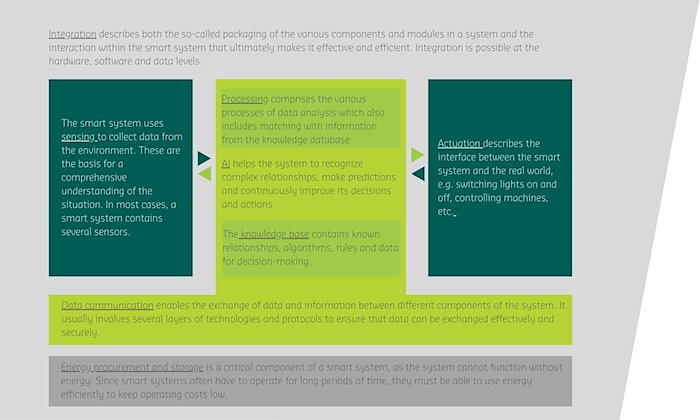If we want to understand how smart systems work, we don’t necessarily have to think technologically. One smart system we are all familiar with is humans themselves. But how do smart systems work in the technological sense? We explain.
Categories
If we want to understand how smart systems work, we don’t necessarily have to think technologically. One smart system we are all familiar with is humans themselves. But how do smart systems work in the technological sense? We explain.

Categories
Tags
Contact info
Silicon Saxony
Marketing, Kommunikation und Öffentlichkeitsarbeit
Manfred-von-Ardenne-Ring 20 F
Fax: +49 351 8925 889
Contact person:
If we want to understand how smart systems work, we don’t necessarily have to think technologically. After all, one smart system we are all familiar with is the human being itself. We humans pick up environmental signals through our senses (hearing, smelling, tasting, feeling). Nerve pathways transmit this information to the brain. The brain processes and evaluates the information, taking our experiences into account. On this basis, it makes complex decisions on how to act and sends corresponding impulses to the muscles of our body.
A smart system in the technological sense reproduces this process. How exactly it makes automated decisions and which components interact with each other is shown in diagrams 1 and 2.

The basic components of a smart system.

The basic components of a smart system and their functions.
Smart systems describe, diagnose and qualify a complex environmental situation based on data. In most cases, data acquisition takes place via sensors. A sensor – just like the human sensory organs – is capable of detecting signals of different types. The most commonly detected signals include temperature, humidity, sound, acceleration, rotation rate, and composition. Because the situations to be detected are often very complex, signals from different sensors are usually detected in one system (multi-sensor).
The sensors convert the specific signals into electrical measurement signals, which in turn form the basis for the system’s analysis and decision to act.
Actuators are components that trigger or perform actions based on data analysis. Specifically, they convert electrical drive energy into mechanical work – just as electrical impulses do in human muscles. Actuators are triggered with a corresponding target function, e.g. switching lights on and off or controlling machines. In simple terms, this makes them the interface between the smart system and the real world.
In addition to triggering actions, it is also possible for special actuators to collect and deliver data for a comprehensive understanding of the situation, e.g. from ultrasound or acoustic signals.
The reason why we talk about “smart” systems today is because of the way they handle the information they acquire. This is because the information-processing processes are increasingly similar to those in the human brain. Through the use of artificial intelligence (AI) and machine learning algorithms, smart systems have the potential to recognize complex facts even faster and better than humans themselves.
To achieve this, the processing of measurement data is a crucial prerequisite. In this context, data processing encompasses the various processes of data analysis – from data preprocessing, data transmission and calculation of variables to comparison with threshold and limit values. In this process, known correlations, algorithms, rules and data for decision-making are used, which are stored in a knowledge store or database. This database also collects sensor data, historical data, or user information that can also be accessed in the decision-making process.
Depending on the application, data analysis is increasingly possible using artificial intelligence methods. AI helps the system to learn, to recognize complex relationships, to make predictions and to continuously improve its decisions and actions.
Only smart systems are thus able to describe, diagnose and qualify their environment in a given complex situation, make predictions or decisions and take appropriate actions.
In order for them to be able to do this, other components are essential for the functionality of the smart system in addition to data acquisition, analysis and decision-making.
In a smart system there are basic modules without which the system cannot function. These can be compared to the human body, which simply cannot exist without nourishment (energy = power supply) and which possesses or produces nerve pathways, receptors, messenger substances, etc. that act as data interfaces between the eye, brain and hand (data transfer). All of these elements must exist within a body in order to function together (integration).
Translated into smart systems, this means the following:
Communication enables the exchange of data and information between different components of the system. It typically involves multiple layers of technologies and protocols to ensure that data can be exchanged effectively and securely. At the innermost level, this often happens by wire. In the communication from system to system or to the environment, various wireless network technologies such as WLAN, Bluetooth or ZigBee are often used.
There is also a wide variety of protocols in the transmission of data from sensors and actuators. For example, protocols such as MQTT or CoAP are used for the transmission of data between system components.
The power supply (energy supply) is a critical component of a smart system, since the system cannot function without energy. Since smart systems are often operated for long periods of time, they must be able to use energy efficiently to keep operating costs low. An efficient power supply can thus also help reduce the carbon footprint of the system itself. In addition to a stationary power supply, rechargeable batteries and energy harvesters are other interesting options.
Integration describes both the so-called packaging of the various components and modules in a system and the interaction within the smart system that ultimately makes it effective and efficient. Integration is possible at the hardware, software and data levels.
Smart systems are capable of independently sensing a complex environment, analyzing it based on knowledge, and making appropriate decisions and predictions. This makes them particularly valuable for a wide variety of application areas. Especially when processes are to be controlled automatically or large amounts of data are available for decision-making. From autonomous vehicles that recognize traffic signs, road users, outside temperature, road conditions and other external factors and react accordingly, to automated lighting control, cleaning and maintenance of buildings, automatic health monitoring via smart watches, and networked machines in production – smart systems can be found in almost all areas of life today.
_ _ _ _ _
👉 Working group Smarts Systems & Internet of Things (Silicon Saxony)
👉 Use Case: Let blind people see again
_ _ _ _ _

Dr. Martina Vogel
Head of Working Group Smart Systems & IoT, Fraunhofer ENAS